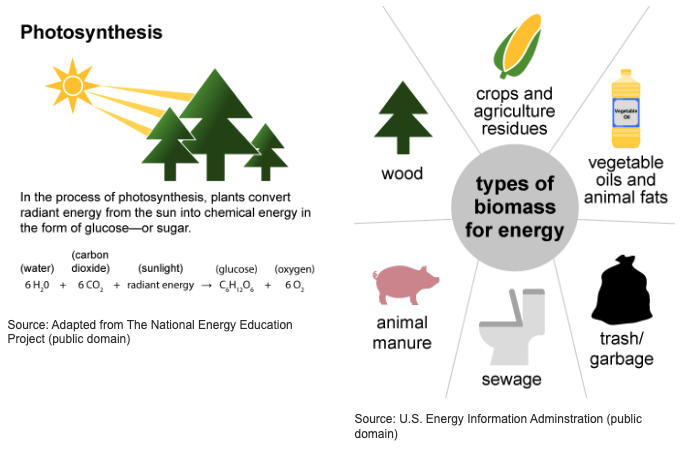Biomass is one of the oldest energy sources around. At the same time, a great deal of confusion surrounds its designation as a renewable energy source. Does biomass really count as a sustainable energy source? Can it be considered an efficient source of energy?
The use of biomass as an alternative to fossil fuels has seen a growth spurt in recent years, a tendency that is bound to increase as renewables continue to go mainstream. And of course, as with other energy sources, you can improve biomass performance by measuring and analysing its consumption, thus making it even more efficient.
Read on to find out how…
What is Biomass?
At times, it may not be entirely clear to users what we mean by biomass, or where and how it can be utilized.
Biomass refers to all organic matter of vegetable and / or animal origin that can be transformed into energy. Some examples include:
- forest and agricultural residues
- organic matter from sewage
- urban solid waste (organic waste)
- other wastes derived from industrial processes (sawmill residues, black liquor…)
Furthermore, biomass falls under alternative energies as it does not come from fossil fuels. We can identify three main types of biomass: residual, natural, and generated. Let’s take a look at these types of biomass below.
3 Main Types of Biomass
As we just saw, we can find 3 different types of biomass. Biomass will belong to one group or another depending on its main characteristics, such as origin or use. These can be:
- Natural Biomass: produced in nature without human intervention.
- Residual Biomass: organic waste produced by human activity. For example, waste from industrial activities. Residual Biomass can be classified as wet or dry.
- Biomass produced by energy crops: crops intended for energy utilization. A specific species is planted to maximize the production of living matter.
Source: Biomass explained. U.S Energy Information Administration.
Through the process of combustion, it releases heat energy, which can be harnessed for electricity generation or utilized for heating residential and commercial structures. Organic matter can be transformed into heat energy, electrical energy or biofuel. Here are some practical applications of biomass as an energy source:
- Biodiesel used in vehicles
- Wood pellets are used in combustion boilers for domestic and industrial heating installations.
- Wood chips
- Olive pits, also used in boilers for heating
- Electric co-generation in industrial kilns for drying wood
- Biogas which produces electricity via co-generation
Advantages of Biomass
Biomass as a source of energy offers numerous advantages over fossil fuels, and the most notable one is its contribution to reducing carbon emissions in the atmosphere.
How is this possible if CO2 is produced during its combustion? Quite simply, the CO2 emitted during combustion was previously absorbed from the atmosphere during the photosynthesis process by vegetation. In this way, biomass maintains a carbon-neutral balance.
7 Advantages of Biomass Use for Energy Generation
The use of biomass offers multiple advantages that make it an attractive option for energy production and for reducing carbon footprint in different sectors:
- Biomass from urban and industrial waste is utilized, often local residues, closing the cycle without the need for transportation, thus promoting the circular economy.
- Biomass from pruning and forest maintenance waste is consumed, consequently preventing forest fires.
- It generates permanent and local employment opportunities.
- Unlike fossil materials such as oil, biofuels can be obtained from a variety of different renewable materials.
- It reduces dependence on fossil fuels, especially in sectors where decarbonization is particularly challenging, such as air transportation.
- It is a key resource for addressing energy poverty in regions where expenditure on fossil fuels represents a significant portion of their Gross Domestic Product (GDP).
- Its utilization promotes efficient use and preservation of natural environments.
For sustainable use, efficient behavior and energy savings in biomass utilization are necessary. At the European Union level, biomass is supported as a renewable source but has not been exempt from debate, particularly forest or woody biomass, derived from wood industry residues and trees directly. Protecting forests and ensuring non-overexploitation are the main issues that raise doubts about biomass.
Biomass in the United Kingdom
Biomass has garnered notable attention within the United Kingdom (UK) as a promising renewable energy resource, poised to curtail carbon emissions. Biomass pertains to organic matter, encompassing wood, agricultural remnants, and refuse, amenable to conversion into energy through varied processes like combustion, gasification, and fermentation. Below is an overview of the biomass landscape in the UK:
Biomass Energy Generation in the UK
Within the UK, a pronounced emphasis has been placed on harnessing biomass for energy production as part of a strategic shift toward a greener economy. Biomass offers a dual-pronged utility in generating both thermal and electrical energy. The methodical incineration of biomass is commonly employed to yield heat, catering to diverse applications such as space heating and industrial functions. Further diversification is witnessed through the conversion of biomass into biogas and biofuels, underpinning electricity generation.
Biomass is playing an increasingly significant role in Britain’s energy mix, mainly due to the conversion of existing coal plants into biomass generation plants. Already in 2015, the country generated 9% of its electricity from biomass. Bioenergy is the second largest source of renewable energy in the UK. In 2021 it was generating 12.9% of the total UK electricity supply.
The factors driving this upshot in biomass use are several:
- The growing necessity to move away from a fossil-fuel-based economy and toward renewables
- To meet climate change targets, including carbon emissions reduction and reporting regulations
- Increases in agricultural production and the need to find alternative uses for excess or waste generated
- Technological advances that optimise the process of biomass energy production
- A regulatory environment that favours the development and use of biomass as fuel, especially thanks to subsidies that convert coal plants to biomass
For instance, over the past decade, Drax has converted four of the plant’s six generating units to biomass from coal.
Renewable Heat Incentive (RHI)
The UK administration launched the Renewable Heat Incentive (RHI) initiative, engineered to galvanise the adoption of renewable heating methodologies, inclusive of biomass. Incentivising both commercial and residential entities, RHI channels financial benefits to those integrating eligible renewable heat technologies, thereby bolstering the integration of biomass-based heating systems.
Biomass Power Installations in the UK
The UK landscape hosts several biomass power installations, pivotal in augmenting the nation’s renewable energy matrix. In 2023, there were 78 power plants using biomass to generate electricity in the UK. These 78 power plants have an estimated power output of 4,158 megawatts, which is enough to power around 8.3 million homes for an hour. These biomass power stations include Ironbridge, the largest in the world with a capacity of 740 megawatts, and Ferrybridge, which has a capacity of around 79 megawatts. These facilities exhibit versatility in their choice of biomass feedstocks, spanning wood pellets, residual agricultural matter, and energy-yielding crops. The ripple effect materialises in kerbing fossil fuel dependency and aligning with the UK’s carbon abatement imperatives.
Sustainability and Ecological Vigilance
Although biomass represents a renewable facet, with perceptible advantages over fossil fuels in terms of emissions, its supply chain raises ecological issues. It is essential to be vigilant in sourcing sustainably sourced biomass feedstocks to prevent ecological encroachment such as deforestation and habitat disturbance. The UK has wisely inserted sustainability criteria to govern biomass sourcing, thereby promulgating sound environmental management.
Biomass Strategy (2023)
This strategy outlines the contribution that sustainable biomass can make towards achieving net zero emissions, the actions the government is taking to facilitate this goal, and areas where additional measures are required. The Biomass Strategy (2023) is divided into five main sections:
Sustainability
The central focus of the strategy lies in sustainability. It is acknowledged that there exist opportunities for enhancing the criteria that govern biomass sustainability. These criteria are crucial for ensuring that biomass contributes to low-carbon and renewable energy and resources. The strategy outlines proposed measures to strengthen the UK’s biomass sustainability standards and commits to conducting a consultation in 2024 on these measures. This includes considering the introduction of a comprehensive sustainability framework that spans multiple sectors.
Availability
Due to the extensive diversity in biomass supply, predicting its future availability is intricate and subject to notable uncertainties. The strategy presents a spectrum of potential sustainable biomass supply scenarios for the UK, based on updated models. The results suggest that both domestically sourced and imported sustainable biomass will play significant roles in supporting biomass utilisation across various sectors of the economy.
Priority use
Given that biomass is a finite resource with uncertain future availability, its utilisation should be prioritised where it can yield the most substantial environmental, economic, and social advantages. The strategy outlines a series of guiding principles for future biomass utilisation and proposes strategies for short, medium, and long-term utilisation to facilitate decarbonisation objectives. The strategy emphasises that applications of biomass capable of generating negative emissions should receive priority consideration in the long term, aligning with the UK’s net-zero aspiration.
BECCS
Bioenergy with Carbon Capture and Storage (BECCS) spotlights a visionary concept, encompassing the capture of carbon dioxide (CO2) emissions emanating from biomass combustion, coupled with subterranean sequestration. This innovation holds the potential to furnish negative emissions, wherein CO2 removal surpasses emission levels. BECCS resonates as a strategic climate mitigation and temperature moderation measure, emblematic of the UK’s climate agenda.
Biomass use across the economy
The strategy provides comprehensive insights into ongoing and planned policy developments in diverse biomass application sectors. These sectors encompass electricity generation, heat production, biomethane generation, transport fuel production, industrial decarbonisation, low-carbon hydrogen production, and non-energy applications. The objective is to optimise the role of biomass in facilitating the UK’s journey to net-zero emissions.
Throughout the strategy, illustrative case studies highlight the diverse range of ongoing innovation projects related to biomass feedstocks and technologies. These initiatives are pivotal to the UK’s pursuit of its net-zero target. Source.
So does Biomass count as a Renewable Energy Source?
Well, it depends on who you ask.
Many energy firms claim that biomass is a more reliable power source than wind or solar.
Although some environmentalists reject the idea that biomass is sustainable at all, both the UK and EU governments officially consider it a low-carbon energy source.
The underlying premise is that since trees absorb carbon as they grow, forest growth will balance the carbon emitted by burning wood for energy. Further, under international greenhouse gas accounting rules set down in the Kyoto Protocol, biomass emissions are recorded in the land-use sector rather than the energy sector in order to avoid “double counting” emissions.
In reality, the situation is much more complex, argues a report by Chatham House, a non-profit think tank in London. A variety of factors influence the overall emissions from burning biomass, including the type of wood used, its fate had it not been used for energy, and what happens to the forest from which it was sourced. Another important factor is the “carbon payback period” or how long it takes for forests to grow back and re-absorb biomass emissions.
While the debate is unlikely to be resolved anytime soon, it is safe to say that while the use of waste biomass (feedstock that does not require extra harvestings, such as sawmill residues, black liquor or post-consumer waste) can be carbon-neutral, biomass obtained from other sources (such as living forests across the ocean) might not be so sustainable.
How much does Biomass Energy Cost?
The million-dollar question… does burning biomass make business sense? As in most cases, it depends on the type of project and resources available. Location plays an important role too; a biomass installation in a remote field in the countryside differs significantly from one in the centre of the city, or if you have chosen a pellet boiler or olive pit as your source material.
The price of a biomass boiler can vary, depending mainly on the type of boiler, fuel type and size. An ordinary commercial installation aimed to heat two or more buildings can cost approximately £20,000.
In terms of the cost of fuel, biomass fuel can deliver cost savings. According to the Forestry Commission of England, woodfuel tends to be cheaper than fossil fuels when replacing electric, LPG, coal or heating oil. The average price of wood pellets is around 3.1p/kWh, which is considerably lower than mains gas at 4.9p/kWh, while electricity costs a whopping 15p/kWh.
However, the price of wood pellets is likely to become more attractive going forward due to their relative stability. While gas prices have continued to rise in recent years in the UK, biomass sources are independent of the fluctuating prices of imported fuels such as gas and oil.
The government has launched the Boiler Upgrade Scheme (BUS) to help cover the costs of installing a renewable heating system – including biomass boilers. As part of this scheme, you can receive up to £5,000 towards the installation of a biomass boiler. Read more.
Is Energy from Biomass Efficient?
As with any other energy source, you can optimise efficiency even further by applying the right technology tools.
Using a flexible energy management solution, you can monitor this energy source easily and analyse its overall efficiency. If you detect that your installation is consuming biomass excessively, you can adjust the consumption rate or replace your boiler with a more efficient one.
For example, if we compare older models of biomass boilers with more current ones, the latter are much more efficient since they consume less energy to produce the same heat.
And how do we increase the efficiency of modern installations?
If we add analysis and control capabilities to our installations, we can make them even more efficient. With the right energy management software you can measure, analyse and control the consumption of biofuel in addition to other sources like electricity, gas and thermal.
Spacewell Energy (Dexma) intelligent solution offers the data-driven insights you need to understand how to make the necessary adjustments and make your installation as efficient as possible.





